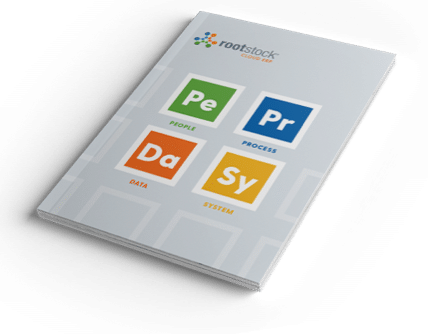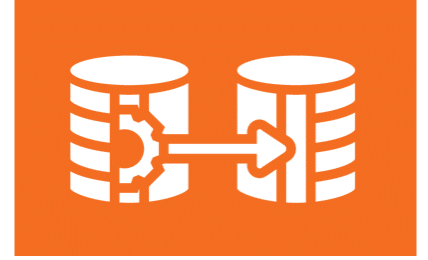Basics of a Successful Cloud ERP Implementation
Four critical elements of successful implementations
Four Critical Elements of Successful ERP Implementation
You’ve just evaluated and selected the right cloud ERP solution for your manufacturing company. However, that’s just the first step in transforming your business. Now comes the hard part: implementation.
But implementing your new cloud ERP system doesn’t have to be so difficult. There are four critical elements that will help ensure a successful cloud ERP implementation:

These areas form the backbone of your ERP software implementation. If you follow the ERP implementation methodology described below, you will not only have a successful ERP implementation, but you will position your company to succeed into the future.
Planning Your Cloud ERP Implementation
A good implementation project plan is more than just a timeline or a checklist of your ERP implementation process. A good implementation plan helps you set realistic expectations and allocate the best resources at the right time, while still retaining the flexibility you’ll need to overcome ERP implementation challenges that arise and make adjustments along the way.
Planning: Define Your Vision
When you’re building your ERP implementation plan, the most important question to ask is, why are we doing this? The answer will serve as a guide for your entire implementation plan.
You may be looking to standardize your operations, maximize flexibility in your sales processes, optimize inventory levels or enhance the customer experience. These are just a few common examples of implementation goals.
Defining a clear business vision at the outset helps you translate your vision, goals and priorities into an ERP implementation plan that focuses on the four critical elements of people, process, data and systems. Your digital strategy might focus on streamlining regulatory compliance or improving inventory management. Or it could be guided by specific improvements and target metrics required by your executive team, or it could be part of a larger digital transformation project.
Planning: Set Realistic Expectations
Often, ERP implementation failures can be traced back to unrealistic expectations. Too many businesses don’t understand the time, money and resources required to help ERP implementation projects succeed.
Organizations with unrealistic expectations will eventually discover that they don’t have the time, money, or resources to complete their ERP implementation project as planned. Following the steps below will provide a framework to guide the team on addressing any challenges they encounter and resolving them for a successful ERP implementation.
Planning: Organizational Change Management in ERP Implementation
Organizational change management is a critical aspect of every cloud ERP implementation project, but it is frequently given low priority or omitted entirely. It’s important to create a change management plan at the beginning that describes how you will help your employees transition to the new system, including training, and define how you will communicate the changes and manage resistance.
Learn More About Cloud ERP for High-Tech and Electronics Manufacturers
Download the Implementation Guide
This eBook will help you build a customized Cloud ERP implementation plan based on four critical elements: people, processes, data, and systems. All four elements come with a short checklist of ERP implementation steps based on hundreds of successful implementations across Rootstock customers.

Learn More About Cloud ERP for High-Tech and Electronics Manufacturers

Choose the Right People for Your ERP Implementation
The first critical element to consider is people, who are the drivers of your cloud ERP implementation process. You need the right people on your team from the start to help ensure a successful ERP implementation.

People: Recruit Executive Sponsors
- You must get the support of the right internal executive sponsors. It’s not enough to have the support of the CEO, who can only create the path and set expectations. Executive sponsors are the ones who influence the day-to-day progress of your implementation. They can be critical to the success or failure of your ERP implementation project.
- During crises, executive sponsors can speed resolution by opening doors, adding resources, and removing roadblocks.
- Executive sponsors can get ad hoc support from subject matter experts during the entire ERP implementation process.

People: Build Your Internal ERP Implementation Team
- Cloud ERP implementation is not just another IT project. You need participation from IT, but also from manufacturing, engineering, operations, IT, quality control, and more.
- Depending on your ERP implementation strategy, you may also need procurement, logistics, sales, and finance to participate.
- Set expectations for the time required from members of these teams.
- Align people and processes with your defined strategy. Successful ERP implementation projects focus on improving operating processes and helping employees develop digital competencies.
- Allow workers and staff to help create and own the vision of a more connected workforce as you are building the business case. This reduces fear and increases ownership and trust.

People: Select an ERP Implementation Project Manager
- The project manager is the person who keeps everyone focused so your implementation meets all deliverables and deadlines.
- The project manager must be detail oriented and must work well with executive sponsors to gain authority, enact changes, and rally support.
- Choose a project manager who has the right attitude, domain expertise and project management skills. Because that set of skills is in high demand, you might need to go outside your company and choose an experienced ERP implementation partner to serve as project manager.

People: Choose an ERP Implementation Partner
- To bring the most experience to your cloud ERP implementation, consider hiring an external ERP implementation partner.
- Most organizations implement an ERP system every couple of decades. External ERP implementation partners are experts with experience in ERP implementation processes in many different industries with similar goals. These experts usually have deep change management, process redesign, and other critical expertise that you need for your ERP implementation project.
- Your solution vendor may also have implementation services. But remember, just as your team members must be a good fit, so must an ERP implementation partner.
Learn More About Cloud ERP for High-Tech and Electronics Manufacturers

Understand Your Processes
Any successful cloud ERP implementation project requires that you have a deep understanding of your current processes. When you see what is working and what is not working, then can you decide what you need to improve.

Processes: Talk to the People Who Really Know the Processes
- In most businesses, there are documented processes and actual processes. If you don’t listen to the people who actually execute these processes, you are likely to miss important details that are not in the documentation.
- Look at process variances across shifts, locations, product lines, and other factors.
- Focus on improving operating processes and helping employees develop digital competencies.
Processes: Document the Current State
- Document every step in your current processes using a logical flow to make it easier to see interactions, data flow, and sequences.
- Document all the workarounds, undocumented deviations, and shortcuts that people take to execute current processes.
- Focus on business process mapping for ERP implementation, which prepares you for moving current processes onto your new platform.
- Take notes along the way, because you’ll find many processes ripe for reengineering once the ERP implementation is successful.

Processes: Choose the Path from Current State to Modern ERP
Depending on your overall vision and strategy, there are multiple paths you can take from your current state to your desired state:
- Use a module-by-module phased approach for ERP implementation.
- Use the big bang strategy for ERP implementation. Companies with multiple locations often use this approach to go live with their new system at one or two locations with similar functionality. Many of these companies implement basic cloud ERP functionality all at once, which accounts for most, but not all of the ERP system.
Modern cloud ERP is ideal for supporting a big bang approach as all implementation and configuration can be completed and tested before going live in production.

Processes: Track Important Metrics
- Focus on measuring only what is critical to the processes that will be impacted by the ERP implementation.
- The dashboards and reports you create should provide the basic information that you really need. There will be time after your successful cloud ERP implementation to create more.
- Your employees can see the impact of their efforts and contributions in the metrics and KPIs that you choose, and you’ll see performance, ownership and commitment increase quickly.
Processes: Create a Testing Plan
- Create a testing plan that encompasses all ERP system roles, including customizing them, combined with stress-testing transactions and integrations for scale and security.
- Your testing plan should provide enough time for every option in every role to be tested and coordinated in the most common process workflows.
- Allow workers to customize roles as part of your usability testing and overall evaluation.
Processes: Create a Training Plan
- Be transparent with workers on why the ERP system is being implemented, including the impact on their jobs.
- Conduct end-user training based on your organizational change management plan.
- Hold customer transition meetings with the cloud ERP software vendor (and your 3rd party implementation partner if you used one) after training to encourage adoption and ownership.
Learn More About Cloud ERP for High-Tech and Electronics Manufacturers

Build Your Data Foundation
Your business runs on data, and cloud ERP has the potential to integrate with many different data sources. But your data may be inaccurate or incomplete, locked in departmental silos, managed by separate teams, or otherwise disconnected. For a successful ERP implementation, your data must be clean, reliable, and accessible.

Data: Start Today
- Map data sources and systems, identify owners, and evaluate data quality.
- Carefully consider the data outside of operations, including finance, sales, customer, and vendor to be included in the new ERP.
- Assign people to examine your data, think about integrations and data flow, and then figure out what you need. Rely on expertise from your business to understand the value of your data.
- Consider bringing in outside ERP implementation data experts to help with technical issues.

Data: Identify Silos
A common problem in manufacturing companies is data separated into departmental or functional silos that don’t connect to each other. A successful ERP implementation helps you build a common platform to break down these data silos.
- Map all your data silos.
- Identify the data owners, processes and systems involved.
- Determine which integrations will be required to break down those barriers.
- Again, consider bringing in outside ERP implementation experts to help with technical issues.
Data: Make Data Its Own Project
Because data is so critical to the success of your new cloud ERP system, create a data project within the overall ERP implementation project. Your data project team must have access to the following dedicated sources to help ensure success:
- Data owners – These are the people who input and understand the data design, data structures, and business requirements in your current system.
- ERP functional team – These are the people, typically from your ERP provider, who understand the ERP system data design and targeted business requirements.
- Data migration team – These people should understand data profiling, cleansing, transformation, and migration techniques. This team must document data migration processes at both a functional and technical level.
- Data project manager – This person must have authority and control over the data project and must completely understand data migration.

Data: Migrate Your Data
Data migration means exactly what is sounds like. But transferring data from your old legacy ERP system isn’t always easy. Migration processes require careful management to ensure success.
- Define a data migration strategy. There are two methods to migrate data to an ERP system:
- Transaction-driven migration allows only active data to be extracted from a legacy system and converted into a file which will then be loaded into your new cloud ERP system.
- Table-driven migration allows migration of whole tables of data from your legacy system with no selection criteria to the new system.
- Review the accuracy of the data to be migrated to make sure it’s all clean, up to date, and error-free.
- Map your data so that it flows freely between departments for testing and go-live tasks.
- Define the data processes, policies, roles, standards, and metrics to ensure efficient use across your entire organization.
Learn More About Cloud ERP for High-Tech and Electronics Manufacturers
Download the Implementation Guide
This eBook will help you build a customized Cloud ERP implementation plan based on four critical elements: people, processes, data, and systems. All four elements come with a short checklist of ERP implementation steps based on hundreds of successful implementations across Rootstock customers.

Learn More About Cloud ERP for High-Tech and Electronics Manufacturers

System: Bring It All Together
System is the fourth critical element in a successful cloud ERP implementation. This is when pull all the pieces together – people, processes, and data – to ensure that the new system matches your expectations.

System: Simplify the Scope
- Use the following ERP implementation phases:
- Implementation
- Go live
- Improvement
- It’s obviously not practical to disrupt large portions of your business at the same time, so keep the scope small to start. Then, as you have success, expand your cloud ERP implementation to other areas of your business.

System: Plan for Integrations
- If you build your cloud ERP system on a platform you currently use, such as Salesforce, integration becomes easy. Sales, service, and other data will already be in the platform, and your business might have existing integrations.
- New integrations take time and planning, so use what you learned in the data component of your ERP implementation to guide and prioritize integrations.

System: Minimize Customizations
- Cloud ERP solutions are highly customizable, but depending on your unique business requirements, may require extensive customization to meet customer needs. Ideally, your selection should be a purpose-built solution for your company with minimal changes to maximize time-to-value.
- External ERP implementation partners can guide process improvements or redesigns and can look at processes as transactional to deliver time, cost, and productivity benefits instead of working to customize your cloud ERP implementation.
- Customizations also slow down training because every ERP customization requires new training.
- ERP customizations add obstacles to future upgrades and modernizations, which could hurt your ROI in the long run.

System: Prepare to Go Live
This is it – the date on which your new cloud ERP system becomes a reality. However, it’s important to start planning well before the go live date.
- Assemble a dedicated go live team.
- Conduct final process walkthroughs.

System: Test Everything
- Test access right permissions and limitations thoroughly, making sure there is accurate data migration by testing each application and its process workflows.
- Test with real case studies and actual production data and run for a month or more, testing business reports and checking them for accuracy.
- Troubleshoot any unforeseen errors that originate in testing.

System: Train Your Workers
- Conduct end-user training based on your ERP implementation training plans defined earlier.
- Conduct customer transition meeting with the ERP software vendor after the training to encourage adoption and ownership.
System: Focus on Continuous Improvement
- Go live isn’t the end of the ERP implementation, it’s the beginning of the continuous improvement of your new cloud ERP solution. Stay focused and keep moving.
- After going live, start closing the remaining gaps, building out niche and secondary requirements, and expanding into new departments and processes.
Additional Resources
Preparing for an ERP Implementation – Best Practices and Lessons Learned
Top 5 Fundamentals of a Successful Cloud ERP Implementation
ERP Implementations Are More Successful Than You Thought
9 Mistakes to Avoid with Cloud ERP
Data Cleansing – A Most Important Step in ERP Implementations
